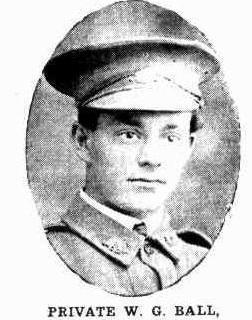Pte
William George Ball
Information about birth
|
Year of birth: 1895 |
|
Place of birth: Wraxall, North Somerset, England, United Kingdom |
General information
|
Profession: Station Hand - Farm Hand |
|
Religion: Church of England |
Army information
|
Country: Australia |
|
Force: Australian Imperial Force |
|
Rank: Private |
|
Service number: 2532 |
|
Enlistment date: 24/07/1916 |
|
Enlistment place: Perth, Western Australia, Australia |
|
Units: — Australian Infantry, 44th Bn. (Last known unit) |
Information about death
|
Date of death: 14/10/1917 |
|
Place of death: Kansas Cross, Langemark, Belgium |
|
Cause of death: Killed in action (K.I.A.) |
|
Age: 22 |
Cemetery
|
Tyne Cot Cemetery Plot: XXXVIII Row: F Grave: 21 |
Distinctions and medals 2
|
British War Medal Medal |
|
Victory Medal Medal |
Points of interest 3
| #1 | Place of birth | ||
| #2 | Enlistment place | ||
| #3 | Place of death (approximate) |
My story
William George Ball was born around 1895 in Wraxall, North Somerset, United Kingdom. He was the son of Herbert Ball and Charlotte A. M. Ball. At the age of 17, he moved with his parents to Australia. There, he became a farmhand. On July 24, 1916, he walked into the recruitment depot in Perth, Western Australia, and enlisted. He was assigned to the 44th Battalion Australian Infantry, First Australian Imperial Force.
In October 1917, the battalion participated in the Battle of Passchendaele. On October 4, they left their trenches to take part in the Battle of Broodseinde (part of the Battle of Passchendaele). Their progress was relatively smooth, and they managed to achieve their objectives near Daring Crossing Road. Additionally, they captured several German prisoners. During the night of October 5–6, they were relieved by the 2/6th Battalion, Manchester Regiment.
On October 9, the battalion moved back towards the front line. In the evening of October 10, they relieved a garrison composed of men from both the Lancashire Fusiliers and the Manchester Regiment. On October 11, the front line remained relatively calm. German sniper fire was quickly dealt with, and one German soldier surrendered. On October 12, the first attack to capture Passchendaele began. The 34th Battalion Australian Infantry was to lead the attack in the sector of the 9 Australian Brigade. Ball’s battalion troops were withdrawn to Hill 40. On October 13, they were sent back to the front line to relieve elements of the 9th Brigade. On October 14, the front line again remained relatively calm. Wounded soldiers were retrieved from no man's land, and a few patrols were conducted at night. On that day, three messengers were also sent to headquarters. Among them was Private Ball. During the delivery of vital messages, the three messengers disappeared. They did not return to the front line, and their bodies were not found.
After the war, William George Ball’s body was exhumed and reburied at Tyne Cot Cemetery, Plot XXXVIII, Row F, Grave 21.
In October 1917, the battalion participated in the Battle of Passchendaele. On October 4, they left their trenches to take part in the Battle of Broodseinde (part of the Battle of Passchendaele). Their progress was relatively smooth, and they managed to achieve their objectives near Daring Crossing Road. Additionally, they captured several German prisoners. During the night of October 5–6, they were relieved by the 2/6th Battalion, Manchester Regiment.
On October 9, the battalion moved back towards the front line. In the evening of October 10, they relieved a garrison composed of men from both the Lancashire Fusiliers and the Manchester Regiment. On October 11, the front line remained relatively calm. German sniper fire was quickly dealt with, and one German soldier surrendered. On October 12, the first attack to capture Passchendaele began. The 34th Battalion Australian Infantry was to lead the attack in the sector of the 9 Australian Brigade. Ball’s battalion troops were withdrawn to Hill 40. On October 13, they were sent back to the front line to relieve elements of the 9th Brigade. On October 14, the front line again remained relatively calm. Wounded soldiers were retrieved from no man's land, and a few patrols were conducted at night. On that day, three messengers were also sent to headquarters. Among them was Private Ball. During the delivery of vital messages, the three messengers disappeared. They did not return to the front line, and their bodies were not found.
After the war, William George Ball’s body was exhumed and reburied at Tyne Cot Cemetery, Plot XXXVIII, Row F, Grave 21.
Sources 3
|
44th Infantry Battalion, (Australian War Memorial, Campbell (AWM), AWM4 23/61/13). https://www.awm.gov.au/ Sources used |
|
Australian Red Cross Wounded and Missing Enquiry Bureau (Australian War Memorial, Campbell (AWM), RCDIG1037077). https://www.awm.gov.au/ Sources used |
|
First Australian Imperial Force Personnel Dossiers, 1914-1920, (National Archives of Australia, Canberra (NAA), B2455, BALL W G). https://www.naa.gov.au/ Sources used |
More information 4
|
Commonwealth War Graves Commission Database https://www.cwgc.org/find-records/find-war-dead/casualty-details/461808 |
|
Namenlijst (In Flanders Fields Museum) https://namenlijst.org/publicsearch/#/person/_id=361e5ddc-fed2-40e6-bbda-2a4b3a4069dc |
|
The AIF Project (UNSW Canberra) https://aif.adfa.edu.au/showPerson?pid=12238 |
|
Lives of the First World War (Imperial War Museum) https://livesofthefirstworldwar.iwm.org.uk/lifestory/7348654 |
